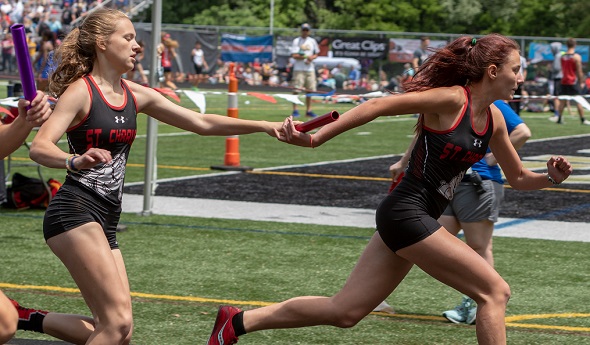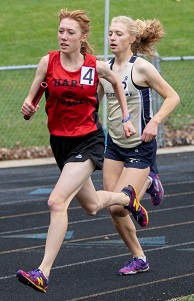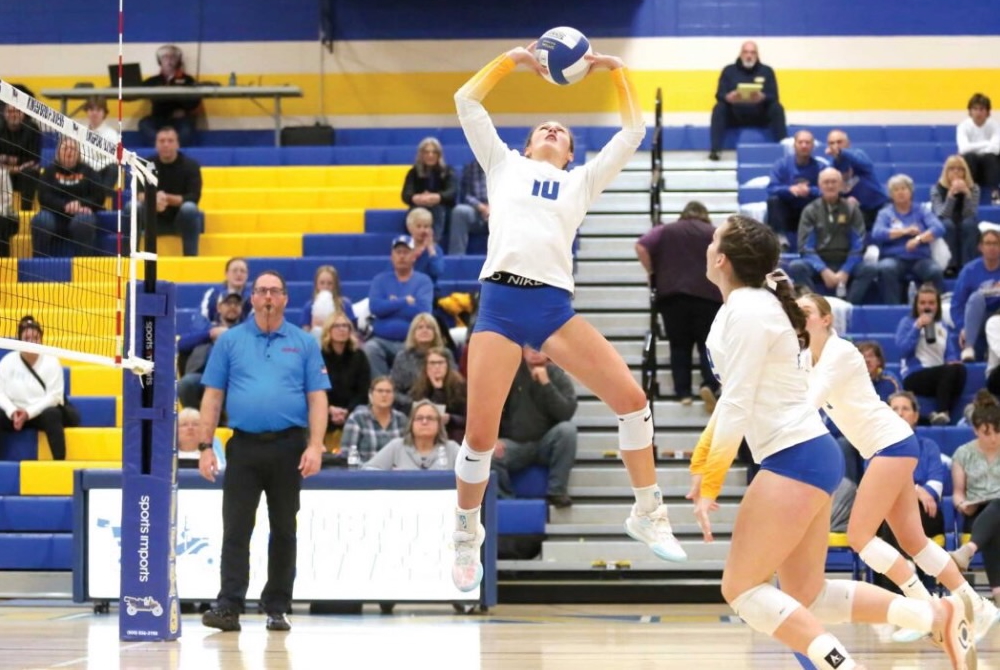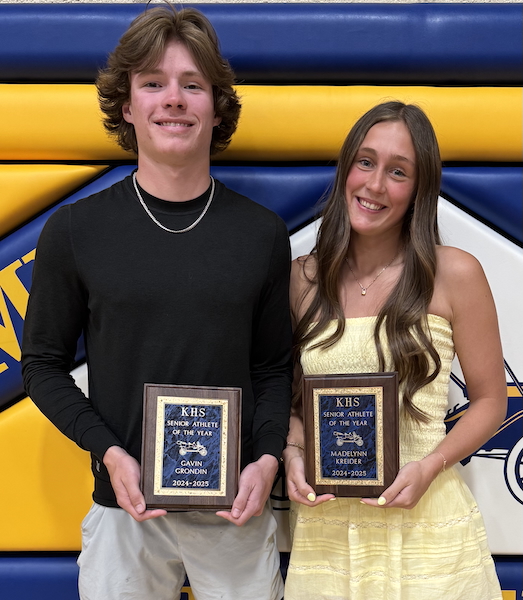
Hart, St. Charles Share Historic Finish
June 2, 2018
By Jeff Bleiler
Special for Second Half
COMSTOCK PARK – Put the Hart and St. Charles teams together, and you’d have had a runaway winner in the Lower Peninsula Division 3 Track & Field Finals on Saturday at Comstock Park.
Hart’s dominance in the distance events and St. Charles’ performances in the sprints would have made it difficult for any other team to challenge for the title.
As it was, each team’s strength countered the other to near perfection as Hart and St. Charles tied for the Division 3 championship with 46 points, earning both their first MHSAA Finals title in this sport.
They finished 10 points ahead of third-place Onsted, which closed the gap by placing fifth in the final event, the 1,600-meter relay. Neither Hart nor St. Charles fielded a team in that event, and Onsted entered it 14 points behind with only 10 available to the winner – so the championship had been decided before that last race even got started.
Both Hart and St. Charles’ coaches were pleased with the shared championship, the first time that’s happened in Division 3 since Laingsburg and Monroe St. Mary Catholic Central split the crown in 2003.
“We had an idea we’d have a chance if we used (junior) Adelyn (Ackley) in three events but didn’t know where she’d end up,” said Hart coach Mindy Whitney, who actually inserted Ackley into a fourth event, which proved critical.
Ackley – who led the cross country team to the LPD3 title in the fall as well – won the 3,200 in 10 minutes, 45.54 seconds; finished runner-up in the 1,600 to Hanover-Horton’s Judy Rector; and placed sixth in the 800, all that after anchoring the winning 3,200 relay in the day’s first event. Alayna Ackley, her older sister, led off and sophomore Brenna Aerts and freshman MacKenzie Stitt filled the second and third slots, respectively, as the relay finished in 9:32.67.
Alayna Ackley also provided valuable points by placing third in the 3,200 despite coming back from a stress fracture injury just last month. The 3,200 was a boon of points for Hart, which picked up 20 in that event alone as the third Ackley sister, freshman Savannah, was fifth.
Whitney said her brother was keeping tabs on the team scoring but after the completion of the 3,200, she thought they came up a point short.
“I was very happy; it was a good day,” she said.
The same could be said for St. Charles, which did its damage in the sprints. Najiyah Holden did the most by winning the 200 in 25.61 seconds, finishing third in the 100 in 12.73 seconds and running the first leg of the winning 400 and 800 relays. The other members of the relays were freshman Hope Kushion and sophomores Erica Garcia and Celine Whiren.
Coach Andre Williams was especially pleased with the 800 relay team’s time of 1:44.97, which broke by three seconds the school record.
“I’m satisfied with (sharing the title),” he said. “After the 400 relay, I knew we had a shot. I told Najiyah she had a shot at winning the 200, and she did. We just don’t have any distance runners.”
 Sprinter Jenna Odykirk of Farwell put to rest previous struggles at the Finals by winning the 100, edging reigning champion Shiyon Taylor of Parchment by two hundredths of a second, and finishing runner-up in the 200.
Sprinter Jenna Odykirk of Farwell put to rest previous struggles at the Finals by winning the 100, edging reigning champion Shiyon Taylor of Parchment by two hundredths of a second, and finishing runner-up in the 200.
Odykirk, who finished a disappointing 16th in the long jump, took solace with her finishes in the sprints after she missed the finals in 2017 in the 200 by one spot and was a distant 16th in the 100.
“I didn’t do too well in the long jump, but I had decent times in everything else,” said Odykirk, whose time of 12.63 seconds in the 100 was a personal best.
Odykirk, a junior, credited the improvement to off season indoor work at Saginaw Valley State University with coach Kyle Payne and outdoor work with Farwell coach Matt Horodyski.
“Next year, my goal is to be state champ in the 200 and the 100, do better in the long jump and run in the 400,” said Odykirk, who qualified this year for the 400 after finishing sixth in the event at last year’s Finals. She opted not to run it Saturday.
In the field events, the shot put provided some late fireworks as Beaverton senior Alicia Aldrich and Clinton’s Amanda Schaare put on quite a show.
In her final attempt with Aldrich on deck, and with the crowd slow clapping as she readied, Schaare heaved it 43 feet, 9¼ inches to move into first. The crowd gave Aldrich a similar slow clap, and she responded with a launch of 44 feet, 7½ inches to take the championship.
“I was like shaking a lot,” Aldrich said. “It feels really great. I wasn’t expecting that at all. The competition really makes you want to throw it farther. I got nervous when I saw Amanda throw it, but then I heard the atmosphere and it pumped me right up.”
Aldrich, who just started competing in shot put last year, will continue in the sport at SVSU.
The runner-up finish for Schaare was not a disappointment as she already had repeated as the discus champion. Schaare won with a toss of 128 feet, beating Sheridan Dinsmore of Caro by six inches.
“(Repeating) was awesome; I really wanted to do that for myself,” Schaare said. “Words just can’t describe it. It’s a feeling that not everyone gets to experience. I just have the greatest support system.”
Schaare’s runner-up put was a personal record, beating the 41-9 she posted early in the season.
“I didn’t finish first in the shot put, but I’m OK with that because with the discus, that would have been icing on the cake,” said Schaare, who will compete in track for the University of Michigan.
Marlette senior Emily Schaub swept the hurdles, winning the 100 hurdles in 15.01 seconds and taking the 300 in 46.96 seconds. She was third in the 100 hurdles a year ago and did not qualify for the 300 final after placing 15th in her 2017 preliminary.
Jackson Lumen Christi freshman Renae Kutcha won the 800 in 58.75 seconds, and Hanover-Horton’s Rector won the 1,600 in 4:52.59. Kutcha also led off the opening leg of Lumen Christi’s winning 1,600 relay team, joining junior Allison Rand, junior Marilyn Schonhard and senior Audrey Warriner with a finish in 4:01.9.
Boyne City senior Anna Harmeling won the pole vault in 11-6, Millington senior Hannah Hall won the high jump at 5-3 and Onsted senior Harlie Sweet won the long jump with a leap of 17-3½.
VIDEO: Holden On For A Bulldogs Co-Championship
PHOTOS: (Top) A pair of St. Charles runners execute a handoff during a relay Saturday. (Middle) Hart's Adelyn Ackley, left, stays a step ahead during one of her relays. (Photos by Annette Tipton. Click for more from RunMichigan.com.)

Kingsford's Kreider Prepared for Next Level After Finishing Stellar Flivvers Career
By
John Vrancic
Special for MHSAA.com
June 19, 2025
KINGSFORD — After completing a successful high school volleyball career, Maddy Kreider is ready to take the next step.
 The Kingsford senior is taking her talents to Michigan Tech, where she’s expected to continue primarily as a setter.
The Kingsford senior is taking her talents to Michigan Tech, where she’s expected to continue primarily as a setter.
“That will be a big step for sure, but it’ll be exciting being with the girls,” she said. “The girls are taller in college. It will definitely be an adjustment, physically and mentally. We’ll be traveling longer distances, and it’ll be a matter of improving the mental part of my game.”
Kreider was selected the Upper Peninsula’s Defensive Player of the Year her final two seasons after the U.P. Sportswriters and Sportscasters Association began voting for all-U.P. volleyball.
“That’s quite an accomplishment,” she said. “It’s a real honor playing with girls I grew up with. We had a great season.”
The 5-foot-8 setter was a four-year starter and two-year team captain at Kingsford, leading the Flivvers to three Division 2 District titles and back-to-back undefeated Great Northern Conference championships. She twice was named GNC Player of the Year.
She was also selected all-state first team in the fall and all-state second team in 2023, and all-region throughout her prep career. Her serving percentage also topped .900 throughout her four seasons on varsity.
 Last fall, the Flivvers reached the Regional Semifinal at Manistique where they dropped a 3-2 decision to Kingsley.
Last fall, the Flivvers reached the Regional Semifinal at Manistique where they dropped a 3-2 decision to Kingsley.
“I thought we’d get through,” Kreider said. “We came out lights out in the first two sets, then it was close in the last three.”
Also among the team’s highlights this past fall was a victory at Calumet, approximately 2½ weeks after dropping a 3-1 decision to the Copper Kings on Kingsford’s home floor.
“We wanted to play them,” Kreider said. “They’re a great bunch of girls to play against. They’ve been the measuring stick up here for many years. Winning on their floor was super exciting. We knew we had to play well just to be competitive. That was a great confidence builder for our group. We were definitely on a high going into the District.”
The Flivvers opened their postseason with a 3-1 triumph over Houghton, then defeated Escanaba in straight sets in the District Final.
Kreider will join Calumet senior Maddie Torola at MTU this fall. Torola, who recorded a season-high 19 kills in the four-set victory at Kingsford, helped the Copper Kings finish 29-5 and reach the Division 3 Regional Final at Sault Ste. Marie where they dropped a 3-2 decision to Traverse City St. Francis.
“It was fun playing against her in high school,” Kreider said. “It will be even more fun playing as teammates. It’ll be exciting to be playing on the same team.”
Both will be playing under new head coach Cindy Pindral at Tech. Both of Kreider’s parents played for the Huskies, her mother (and Kingsford varsity coach) Jaclynn volleyball from 1998-2002 and her father Jason basketball from 1997-2000.
Maddy Kreider recently earned an additional honor when she was selected Female Athlete of the Year for Kingsford’s Class of 2025. She recently completed a solid track & field season for the Flivvers.
At the U.P. Division 1 Finals, Kreider placed fourth in the 100-meter dash (13.2) and anchored the Flivvers to a third-place finish in the 800 relay (1:51.57) and fourth in the 400 (53.03) on their home track.
Kreider was named one of 32 MHSAA/Farm Bureau Insurance Scholar-Athlete Award winners this winter and plans to study exercise science and kinesiology at MTU.
 John Vrancic has covered high school sports in the Upper Peninsula since joining the Escanaba Daily Press staff in 1985. He is known most prominently across the peninsula for his extensive coverage of cross country and track & field that frequently appears in newspapers from the Wisconsin border to Lake Huron. He received the James Trethewey Award for Distinguished Service in 2015 from the Upper Peninsula Sportswriters and Sportscasters Association.
John Vrancic has covered high school sports in the Upper Peninsula since joining the Escanaba Daily Press staff in 1985. He is known most prominently across the peninsula for his extensive coverage of cross country and track & field that frequently appears in newspapers from the Wisconsin border to Lake Huron. He received the James Trethewey Award for Distinguished Service in 2015 from the Upper Peninsula Sportswriters and Sportscasters Association.
PHOTOS (Top) Kingsford’s Maddy Kreider sets for her teammates during a match last season. (Middle) Kreider, right, takes a photo with Kingsford’s Male Athlete of the Year Gavin Grondin. (Photos provided by the Kingsford athletic department.)

